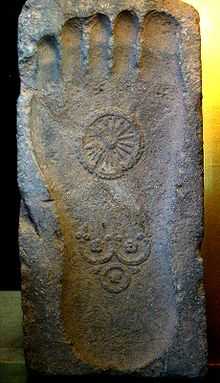Cetiya
The cetiya, "reminders" or "memorials" (Sanskrit: caitya), are objects and places used by Theravada Buddhists to remember Gautama Buddha.[1] These are traditionally divided into three categories: śarīraka, pieces of the body, paribhogaka, things he used, and udeśaka, reminders. A fourth category, dhammaka, was added later to remind monks that the true memory of Gautama Buddha can be found in his teachings.[2] While these can be broadly called Buddhist symbolism, the emphasis tends to be on a historical connection to the Buddha and not a metaphysical one.
Śarīraka
The śarīraka or dhātu cetiya, reminders of Buddha's body, are the category commonly considered "relics" today by Western observers, and were responsible for major forms of Buddhist art and symbolism, although they only constitute one of the three categories of reminders.[1] Most frequently preserved parts of Buddha's body are tooth and bone, because these parts would remain after the rest of the body decayed. The relic of the tooth of the Buddha in Sri Lanka is the most notable site where a relic is visibly preserved, but hundreds of such sites were created, in the architectural form now called a stupa. In Thai, these stupas are called chedī, retaining the second half of the phrase dhātu cetiya; in Lao they are called that after the first half.[3] Beyond the stupa itself, sarīraka are used across the Buddhist world, in such quantity that not all could be legitimate; in this sense the śarīraka functions mainly as a symbol, with the importance of authenticity varying between cultures.
More relics of bone were discovered during archaeological excavations of a stupa built in Peshawar, Pakistan by the Kushan Emperor Kanishka in the second century A.D. In 1909, three pieces of bone (approx 1½ in. or 3.8 cm long) were found in a crystal reliquary in a bronze casket bearing an effigy of Kanishka and an inscription recording his gift.[4][5] They were removed to Mandalay, Burma by the Earl of Minto, Viceroy and Governor General of India, in 1910, for safekeeping.[6] They were originally kept in a stupa in Mandalay but this has become dilapidated and is used for housing. The relics are meanwhile being kept safely in a nearby monastery until funds can be found to build a new stupa to house the relics next to Mandalay Hill. The crystal reliquary holding the bones is now enclosed in a gold and ruby casket provided by Burmese devotees. The miniature gold stupa in which they were transported to Mandalay may be seen in the photo to the right of the modern ruby and gold reliquary.
The body parts of especially powerful monks are also called śarīra, but these usually take on the form of bright jewels formed during the cremation of the body.
Paribhogaka
The paribhoga cetiya, things used by the Buddha, would seem at first to be a nonexistent category today, however like the contentious Shroud of Turin temples such as Tongdosa in South Korea claim to keep his robe and begging bowl. [7] However, the category also includes all places the Buddha visited, so Bodh Gaya itself functions as a paribhogaka. The most common paribhogaka is the bodhi tree,[1] which was transplanted across Southeast Asia; cuttings of the original bodhi tree apparently still survive today in Sri Lanka.

Another extremely common paribhoga-cetiya is the Buddha footprint, an imprint made across the Buddhist world to symbolize the ground that Buddha walked on and the powerful size of his "dharma body". Sometimes these footprints are also classed as udeśaka, a representation of the Buddha's foot, or śarīraka, implying that the footprint was the foot itself.
Udeśaka
The final category, udeśaka or uddesika cetiya, literally translates as "indicative reminders" or "votive objects", for example images of the Buddha.[1] Udeśaka do not have any physical connection to the Buddha but still serve as relics because they were created in his memory. Originally udeśaka were secondary to paribhogaka and śarīraka, but with the influence of Greco-Buddhism statues of the Buddha were produced in great numbers, followed later by paintings and other images. The dharmacakra, wheel of dharma, falls under this category as a reminder of Buddhist insight.
The conventional view has long been this meant that early Buddhist art was aniconic. However, this view has recently been the subject of debate among specialists. There does not seem to have been any prohibition of creating images of the Buddha. Rather, creating images of the paribhogaka was regarded as a more fulfilling and meaningful symbol by the early Buddhists, evoking the discovery of Buddhist understanding (prajñā/pañña).[8] Whether these scenes contained substitutes for the image of Buddha himself is currently under debate.[9]
See also
References
- ↑ 1.0 1.1 1.2 1.3 Kalingabodhi jātaka, as quoted in John Strong, Relics of the Buddha (Princeton: Princeton University Press, 2004), 19
- ↑ Alexander B. Griswold, What is a Buddha Image? (Bangkok: Fine Arts Department, 1968), 14-15
- ↑ Pierre Pichard, François Lagirarde, The Buddhist Monastery (École française d'extrême-orient, 2003), 171
- ↑ "Two Gandhāran Reliquaries" K. Walton Dobbins. East and West, 18 (1968), pp. 151-162.
- ↑ "Is the Kaniṣka Reliquary a work from Mathurā?" Mirella Levi d’Ancona. Art Bulletin, Vol. 31, No. 4 (Dec., 1949), pp. 321-323.
- ↑ The Stūpa and Vihāra of Kanishka I. K. Walton Dobbins. (1971) The Asiatic Society of Bengal Monograph Series, Vol. XVIII. Calcutta.
- ↑ http://www.orientalarchitecture.com/koreasouth/busan/tongdosa.php
- ↑ Susan L. Huntington, "Early Buddhist Art and the Theory of Aniconism". Art Journal 49.4 (1990); Jacob N. Kinnard, Imagine Wisdom: Seeing and Knowing in the Art of Indian Buddhism. Motilal Banarsidass Publ., 2001
- ↑ Susan L. Huntington, "Aniconism and the Multivalence of Emblems: Another Look". Ars Orientalis 22 (1992).